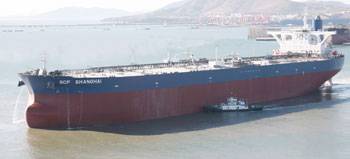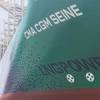Sovcomflot Reports “Strong Start” for Q1 2014
Russian shipping company Sovcomflot, a global top-five tanker company, reported its financial results for the first quarter of 2014. The company, which offers crude oil, refined petroleum products and liquefied gas transportation services, recorded a “strong start” with highlights as listed below.
Q1 2014 Highlights:
•Gross revenue (freight and hire) increased 16.5 percent to $361.5 million
•Time charter equivalent (TCE) revenues increased 34.1 percent to $270.6 million
•EBITDA increased 65.7 percent to $153.6 million
•Net profit reached $58.1 million (as compared to $2million in Q1 2013)
•Significant growth in the crude oil transportation segment: TCE revenues increased by 56.1 percent to $134.7 million
•Further expansion of LNG fleet with the delivery of Velikiy Novgorod, tri-fuel 170,200m³ Atlanticmax ice class LNG carrier - first vessel in a series specially designed for and employed under a long-term charter by Gazprom Group
•Entry into service of VLCC SCF Shanghai (321,280 tonnes dwt) engaged on a long-term time-charter agreement with PetroChina International (a subsidiary of China National Petroleum Corporation, CNPC)
•Successful completion by SCF Group’s company, Novoship, of modernization at the Port of Sochi for 2014 Winter Olympic Games.
Sergey Frank, President and CEO of OAO Sovcomflot, said, “Following five years of recession, the tanker market is showing the early signs of a long overdue recovery. Throughout the down-cycle, Sovcomflot’s robust business model has continued to deliver. Our balanced chartering policy whilst being conservative enough makes us well positioned for the upswing in the market. By focusing on servicing the transportation needs of our core clients and on large-scale industrial projects, in the hydrocarbons sector, we have benefited from better vessel utilization and long-term contracted revenues. The group’s future contracted revenues of $6.7 billion provide welcome protection against volatility in the tanker markets and a solid basis for the further growth of our business.”
Frank continued, “During the first quarter of 2014 we continued to implement the group’s development strategy. This is designed to ensure that we continue to use state-of-the-art technologies across our fleet, in order to serve the evolving needs of our clients. Specifically, we aim to provide safe and reliable transportation for the developing oil and gas fields in the Arctic and sub-Arctic regions.
Q1 2014 Financial Highlights
Gross revenue (freight and hire receivable) increased by 16.5 percent to $365.1 million (Q1 2013: $313.2 million). After accounting for voyage costs and commissions, TCE revenues increased by 34.1 percent to $270.6 million (Q1 2013: $201.8 million). Earnings before interest, tax, depreciation and amortization (EBITDA) increased by 65.7 percent to $153.6 million (Q1 2013: $92.7 million). Meanwhile, profit for the period rose 29.1 fold to $58.1 million (Q1 2013: $2million). This good overall performance reflected stronger market dynamics in the crude oil transportation segment and a growing contribution from the gas transportation and offshore segments to the Group’s results.
Total assets at March 31, 2014 were $6,562.5 million (March 31, 2013: $6,408 million). The group maintained stable net debt ratios throughout the period, with a slight overall decline in gearing (leverage) at the quarter end to 45.8 percent (March 31, 2013: 46.3 percent).
At the end of Q1 2014, the group had contracted future revenues of $6.7 billion, reflecting the long-term nature of its chartering arrangements. This earnings visibility is made more significant by the presence of strong chartering counterparties (i.e. significant Russian and international oil and gas companies).
The group’s cash position as at March 31, 2014 saw cash of $335.7 million (March 31, 2013: $179.6 million), reflecting the improved performance from the crude oil transportation segment and also a number of vessel sales (see Fleet Summary below).
Q1 2014 Business Segment Highlights
Crude Oil Transportation
This segment performed well in the three months to March 31, 2014, with TCE revenues increasing by 56.1 percent to $134.7 million. This performance reflected stronger underlying dynamics in the crude oil transportation segment in general, and a firming of daily time charter rates, which began in the third quarter of 2013 and continued throughout the first quarter of 2014.
On February 25, 2014 SCF Shanghai, a 321,280 metric tons DWT Very Large Crude Carrier (VLCC), joined the Groups fleet. The vessel was constructed at the Bohai shipyard in Huludao China and is the second VLCC in the Svet class – the largest vessels in the Russian merchant fleet. As with her sister ship Svet, the tanker is operating under a long-term time-charter agreement with PetroChina International (a subsidiary of China National Petroleum Corporation, CNPC).
Oil Products Transportation
In contrast to the crude oil transportation market, conditions in the oil products transportation segment were less favourable with operating margins remaining under significant pressure. Against this background, TCE revenues increased by 1.9 percent to $53.1 million during the first quarter, compared with the same period in 2013.
Gas Transportation
The group’s TCE revenues increased by 81.8 percent to $20.7 million in the three months to March 31, 2014, compared with Q1 2013. On February 2, 2014, Sovcomflot took delivery of Velikiy Novgorod. This advanced design 170,000 cubic meters capacity LNG carrier is constructed to ice class Ice2 and is engaged on a 15 year time charter to Gazprom.
The group’s corporate strategy places a priority on the development of its LNG transportation activities. To this end there were four LNG vessels on order at the period end, each of over 170,000 cubic meters capacity, for delivery up to Q1 2016. All the vessels have long-term time-charter arrangements in place with Gazprom, Shell or Yamal LNG as charterers.
Offshore Development Services
The offshore segment saw TCE earnings grow by 14.2 percent in the period to March 31, 2014, compared with Q1 2013, to reach $54.8 million. The development of this higher margin business segment is identified as a priority in the group’s business strategy.
Other
This segment includes the group’s interests in the operation of dry bulkers and seismic vessels and is by far the smallest business segment within SCF Group. During the period TCE revenues increased by 77.8 percent over Q1 2013 to $8 million
The success of the Sochi 2014 Winter Olympics reflected many years of careful planning and investment, involving a significant number of stakeholders including SCF Group. The group’s subsidiary companies Novoship and Sochi Sea Port invested in developing a modern yachting marina, partial restoration and modernization work of a historic building at the sea terminal.
Fleet Summary
In the first quarter of 2014, two vessels were delivered – Velikiy Novgorod (LNG carrier of 170,000 cubic meters capacity) and SCF Shanghai (321,280 metric tons DWT), the group’s second VLCC. During the period three vessels were sold, the Suezmax tankers SCF Byrranga and SCF Aldan and the LNG tanker SCF Polar.
As at March 31, 2014, SCF Group’s fleet comprised 158 vessels (including vessels in joint ownership with third parties) with a combined deadweight of over 12 million metric tons: 134 owned vessels; two chartered-in vessels; nine escort tugs which have been chartered-out on bareboat charter to an associate company – Rosnefteflot; as well as four LNG carriers and nine LR1 product carriers in joint-venture companies. A total of four vessels, with a total deadweight of 477,600 metric tons were on order as at March 31, 2014. This included: three LNG carriers (Ice-class Ice2, 170,000 cubic meters capacity) and a state-of-the-art Arctic LNG carrier (Ice class Arc7, 172,000 cubic meters capacity).
scf-group.com















